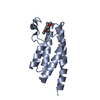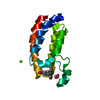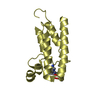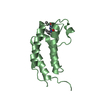Details Solution-ID Contents Solvent system 1 1.3mM TAR, 1.3mM TAR*GA, 10mM sodium phosphate, 50mM sodium chloride, 0.01mM EDTA, 0.4g/L sodium azide, 100% D2O100% D2O2 1.1mM TAR, 1.1mM TAR*GA, 10mM sodium phosphate, 50mM sodium chloride, 0.01mM EDTA, 0.4g/L sodium azide, 90% H2O/10% D2O90% H2O/10% D2O3 0.37mM [U-98% 13C; U-98% 15N] TAR, 0.74mM TAR*GA, 10mM sodium phosphate, 50mM sodium chloride, 0.01mM EDTA, 0.4g/L sodium azide, 90% H2O/10% D2O 90% H2O/10% D2O4 0.74mM TAR, 0.37mM [U-98% 13C; U-98% 15N] TAR*GA, 10mM sodium phosphate, 50mM sodium chloride, 0.01mM EDTA, 0.4g/L sodium azide, 90% H2O/10% D2O 90% H2O/10% D2O5 1.6mM TAR, 0.8mM [U-98% 13C; U-98% 15N] TAR*GA, 10mM sodium phosphate, 50mM sodium chloride, 0.01mM EDTA, 0.4g/L sodium azide, 100% D2O 100% D2O6 0.5mM [U-98% 13C; U-98% 15N] TAR, 1.0mM TAR*GA, 10mM sodium phosphate, 50mM sodium chloride, 0.01mM EDTA, 0.4g/L sodium azide, 100% D2O 100% D2O7 1.8mM TAR, 0.9mM [U-98% 13C; U-98% 15N] TAR*GA, 10mM sodium phosphate, 50mM sodium chloride, 0.01mM EDTA, 0.4g/L sodium azide, 100% D2O 100% D2O8 1.8mM TAR, 0.9mM [U-98% 13C; U-98% 15N] TAR*GA, 10mM sodium phosphate, 50mM sodium chloride, 0.01mM EDTA, 0.4g/L sodium azide, 100% D2O 100% D2O
Sample Show large table (4 x 48) Hide large table Conc. (mg/ml)Component Isotopic labeling Solution-ID 1.3 mMTAR1 1.3 mMTAR*GA1 10 mMsodium phosphate1 50 mMsodium chloride1 0.01 mMEDTA1 0.4 g/Lsodium azide1 1.1 mMTAR2 1.1 mMTAR*GA2 10 mMsodium phosphate2 50 mMsodium chloride2 0.01 mMEDTA2 0.4 g/Lsodium azide2 0.37 mMTAR[U-98% 13C; U-98% 15N] 3 0.74 mMTAR*GA3 10 mMsodium phosphate3 50 mMsodium chloride3 0.01 mMEDTA3 0.4 g/Lsodium azide3 0.74 mMTAR4 0.37 mMTAR*GA[U-98% 13C; U-98% 15N] 4 10 mM
 Yorodumi
Yorodumi Open data
Open data Basic information
Basic information Components
Components Keywords
Keywords Function and homology information
Function and homology information Authors
Authors Citation
Citation Journal: Proc.Natl.Acad.Sci.Usa / Year: 2008
Journal: Proc.Natl.Acad.Sci.Usa / Year: 2008 Structure visualization
Structure visualization Molmil
Molmil Jmol/JSmol
Jmol/JSmol Downloads & links
Downloads & links Download
Download 2rn1.cif.gz
2rn1.cif.gz PDBx/mmCIF format
PDBx/mmCIF format pdb2rn1.ent.gz
pdb2rn1.ent.gz PDB format
PDB format 2rn1.json.gz
2rn1.json.gz PDBx/mmJSON format
PDBx/mmJSON format Other downloads
Other downloads https://data.pdbj.org/pub/pdb/validation_reports/rn/2rn1
https://data.pdbj.org/pub/pdb/validation_reports/rn/2rn1 ftp://data.pdbj.org/pub/pdb/validation_reports/rn/2rn1
ftp://data.pdbj.org/pub/pdb/validation_reports/rn/2rn1 Links
Links Assembly
Assembly
 Components
Components Sample preparation
Sample preparation Movie
Movie Controller
Controller













 PDBj
PDBj




























